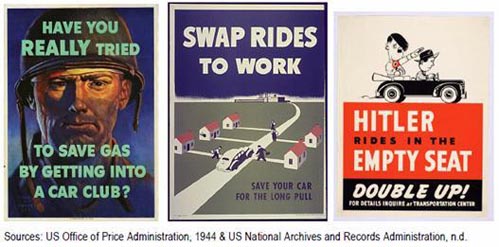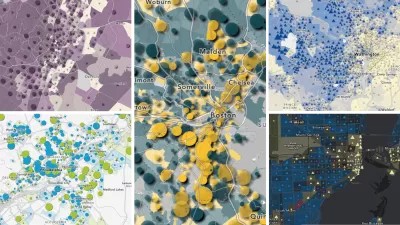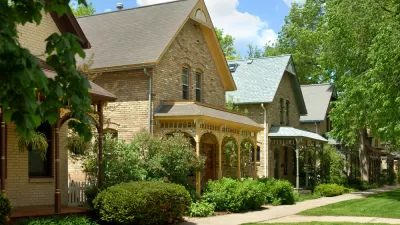Recent census data analysis shows that the number of carpoolers has been declining over the last thirty years. But further study of carpooling's history, as well as social, demographic and economic trends, shows that there is more to carpooling numbers than a downward slope, writes Cynthia Armour.
The latest census data spurred concerns that carpools might not be the forerunner of alternative transportation we thought it was. Articles were written decrying the 49% drop in percentage of US workers who carpool. Although there is no use in refuting this number, there is little reason to call it a trend, and there is a benefit in taking a closer look at the situation.
Stating that the "decline continues," as an article in The Urban Transportation Monitor did at the time, is not looking at the whole picture. The lion's share of the drop, for example, happened from 1980 to 1990. This drop is mainly due to a change in the federal government's involvement, economic factors and demographic changes.
Furthermore, the real number of carpoolers actually increased from 1990 to 2000 – just not as fast as the overall growth of commuters. Finally, it seems that since 2005 the percentage of US workers who carpool has been bucking the trend and actually increasing.

Political and Economic Factors
Fluctuations in the Disposable Personal Income of households as well as gas prices have an undeniable effect on carpool participation. The correlation between carpool and gas prices has a Pearson's R factor of 0.65, and the DPI and carpool have one of -0.63. The financial impetus to carpool also leads us to the conclusion that less subsidies geared towards privately owned vehicles would improve rideshare numbers.
Less visibly, societal and demographic changes influence carpool participation.
One example is the ratio of cars to people. In the last thirty years, car ownership has grown faster than population. The number of cars parked in American driveways rose by nearly 60% since 1980, while the number of Americans has grown by a third. This, combined with the ongoing suburbanization of homes and decentralization of jobs, shines a light on the decline of carpooling. As schedules become more flexible, cars more affordable and two-earner households (usually with jobs in two different directions) more common, carpooling becomes less and less attractive.
Finally, we take a look at government policy towards rideshare. Up until the 1980s, public policy had a favorable influence on carpooling. In the 1940s, for example, the government worked with the private industry to encourage ridesharing. An ad campaign was launched by the Products Conservation Committee. At the end of the war, it is estimated that 8m dollars of private money (i.e. petroleum industry) were spent to support conservation efforts.
In the 1970s, the energy crisis brought ridesharing back into the government's field of vision. President Nixon's administration enacted a number of measures providing funding for carpool initiatives. President Carter's administration was also a great proponent of rideshare. Not only did he appoint a National Task Force on ridesharing, he tried to eliminate subsidized parking for federal employees (which has a negative effect on ridesharing) and introduced a bill which sought to create a National Office of Ridesharing.
To the effect of explaining the recent Census data numbers, one last point comes to mind: The Census questionnaire asks commuters what is their "mode of transportation to work." It is plausible that a non-negligible number of commuters who choose to carpool do so irregularly. This goes along with the rise of tele-working, which most commonly takes place once or twice a week. Therefore the census data would not account for these more occasional forms of transportation.
The present trend
Since 2001, the percentage of US workers who choose to carpool to work has been relatively stable, hovering around 10%. This stability leads us to hope that as the mindset of US workers towards carpool changes, their financial and time-related needs change, and their options are broadened, carpooling stands a good chance of remaining an important part of our portfolio of mobility options.
In Ridesharing in North America: Past, present and Future (2010), Chan and Shaheen present four key developments that will be affecting rideshare's numbers in the close future. These key developments are:
- Partnerships between ridematching software companies and regions and large employers
- Financial incentives for "green trips" through sponsors
- Social networking platforms that target youth
- Real-time ridesharing services
In the conclusion to his thesis on real-time rideshare pilot programs, Andrew Amey concurs with these findings, noting that the single most effective policy in encouraging people to carpool is employer outreach.
And according to a 1990 paper by Hwang and Giuliano, employees from a firm with a ride matching service carpool 10% more than without a matching service. Furthermore, public transportation rates were 1.95% for firms with matching programs and 1.91% for firms without matching programs – thus showing that transportation demand management efforts visibly affected was rideshare without hurting public transportation rates.
As to new technologies and social trends, John Latta believes we are entering "a new era," enabled by the growing importance of social networks that pervade each day more aspects of our lives. New smart phone apps and more intuitive software will help us find efficient and easy-to-use shared rides. Technology thus plays a major role in overcoming carpool barriers such as perceived ease-of-use and flexibility.
Finally, as our society adapts to these new tools, our perception of carpooling will change as well. Already alternative forms of transportation are becoming more socially acceptable than they were ten years ago. For a long time, car ownership was an important social meter: people who did not own cars were outcasts. Without a car you had no independence, you had no social stature. Hollywood played an important role here, as seen in a recent article published in Slate magazine, Dude, Where's Your Car?: How not having a car became Hollywood shorthand for loser. As going to work by car becomes less attractive, bicycling to work is seen as an efficient, cost-saving and positive form of commuting. And so can carpooling.
A quick look at Zimride, a three-year-old startup making its niche in the carpool market, illustrates this point. Zimride is a "social ridesharing network" with a drastically different approach to the commuters' world. The simple fact that Zimride, as a company, sees carpooling as a profitable market in which to thrive is enough.
A Look to the Future
As more and more studies decry the use of the automobile as an inefficient and harmful way of getting to work, we must seek ways to liberate ourselves from it. The more money we spend on infrastructure, the worse it seems congestion becomes. The fact is that there is no one solution to improving our commute. We are best served by trying to expand in all directions: improving our portfolio of mobility options.
Carpooling has been one such option for a long time. The empty seats in commuters' cars are, as stated by Randy Rentschler of the Bay Area Metropolitan Transportation Commission, "the single largest transport resource ( ) in the entire country." Encouraging rideshare is, after all, an easy and cost-effective solution to helping reduce congestion and gas emissions. Continued public policy to create incentives for rideshare, as well as further collaboration between ride matching services and employers will guarantee continued enthusiasm for ridesharing as a means of getting to work.
The decline depicted by the Census data does not show the whole picture. As Americans change the way they live, work, and travel, so do our mentalities and habits. Carpooling is far from dead – it is there, an option in times of need. Let's not discredit what it has to offer.
Cynthia Armour recently received her Masters of Political Science from UC Santa Cruz. She is French-American and has worked with the Bay Area's Metropolitan Transportation Commission, car-sharing company Zipcar as well as France's rail network manager, Réseau Ferré de France.

Maui's Vacation Rental Debate Turns Ugly
Verbal attacks, misinformation campaigns and fistfights plague a high-stakes debate to convert thousands of vacation rentals into long-term housing.

Planetizen Federal Action Tracker
A weekly monitor of how Trump’s orders and actions are impacting planners and planning in America.

In Urban Planning, AI Prompting Could be the New Design Thinking
Creativity has long been key to great urban design. What if we see AI as our new creative partner?

Cal Fire Chatbot Fails to Answer Basic Questions
An AI chatbot designed to provide information about wildfires can’t answer questions about evacuation orders, among other problems.

What Happens if Trump Kills Section 8?
The Trump admin aims to slash federal rental aid by nearly half and shift distribution to states. Experts warn this could spike homelessness and destabilize communities nationwide.

Sean Duffy Targets Rainbow Crosswalks in Road Safety Efforts
Despite evidence that colorful crosswalks actually improve intersection safety — and the lack of almost any crosswalks at all on the nation’s most dangerous arterial roads — U.S. Transportation Secretary Duffy is calling on states to remove them.
Urban Design for Planners 1: Software Tools
This six-course series explores essential urban design concepts using open source software and equips planners with the tools they need to participate fully in the urban design process.
Planning for Universal Design
Learn the tools for implementing Universal Design in planning regulations.
Appalachian Highlands Housing Partners
Gallatin County Department of Planning & Community Development
Heyer Gruel & Associates PA
Mpact (founded as Rail~Volution)
City of Camden Redevelopment Agency
City of Astoria
City of Portland
City of Laramie





























